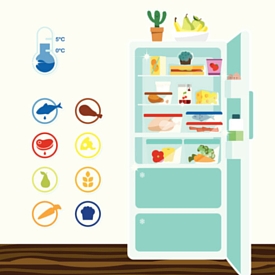
Organize your fridge for safety and sanity.
Keeping your refrigerator clean affects the performance of your appliance, as well as the quality and safety of your food.
Proper performance starts on the outside, with a seasonal cleaning.
- Unplug the appliance and move it away from the wall.
- Vacuum your coils with the dusting attachment or the crevice attachment for small or hard to reach places. Can’t find your refrigerator coils? Consult your owner’s manual.
- Dust underneath the kick plate by using a coil brush or a yard stick covered in some old panty hose.
Now that you’ve taken care of the seasonal maintenance, let’s go inside.
- Remove all items in the refrigerator, tossing any that are past their prime. Keep food cool while you are cleaning; using your freezer or a cooler filled with ice are both convenient ways to prevent spoilage.
- Remove any drawers and place in a sink of hot, soapy water.
- Wipe down the interior of the fridge including all seals with a mild soap or a homemade solution of equal parts vinegar (or lemon juice) and water. Sprinkle baking soda on tough spills for gentle abrasion to help remove the spill mark. Make certain to rinse cleaning cloths often and thoroughly.
- Wash the soaking drawers, rinse, dry and return them to the refrigerator.
- Now you are ready to organize properly.
A well organized refrigerator keeps food from spoiling, keeps food fresh and most importantly prevents food borne illnesses.
TOP: Dairy products, eggs in their original carton
MIDDLE: Store prepared foods and leftovers here
BOTTOM: Keep all raw meat, poultry and seafood on the bottom shelf to prevent any spillage and contamination of raw foods. Place raw meat, poultry and seafood on a rimmed plate or other deep container to further prevent dripping.
DRAWERS: Store your fruits and vegetables in the storage drawers designed for them. Do not store fruits and vegetables in the same drawers if possible.
DOOR: Keep juices, condiments, dressings and other items with a long shelf life here.
Tips to keeping your fridge and all its contents fresh:
- Keep your refrigerator temperature to 40 degrees or below.
- Wipe up spills immediately to avoid growth of bacteria and cross contamination.
- Don’t overfill your fridge; there should be enough space for cold air to circulate.
- Keep similar foods together to allow you to find them, rotate them and use them before they spoil.
- Eat leftovers within four days.
For more information on food safety and storage review this chart.


